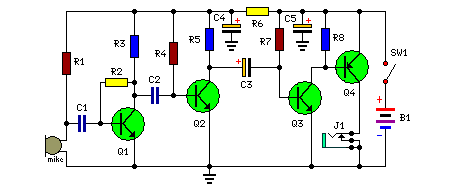FREE
circuits!
How to build Hearing Aid
August 5, 2010 - category: Audio amplifierDescription
Commercially available hearing aids are quite costly. Here is an inexpensive hearing aid circuit that uses just four transistors and a few passive components.
Circuit diagram
Parts:
- R1 = 2.2K
- R2 = 680K
- R3 = 3.3k
- R4 = 220K
- R5 = 1.5K
- R6 = 220R
- R7 = 100K
- R8 = 680K
- C1 = 104pF
- C2 = 104pF
- C3 = 1uF/10V
- C4 = 100uF/10V
- C5 = 100uF/10V
- Q1 = BC549
- Q2 = BC548
- Q3 = BC548
- Q4 = BC558
- J1 = Headphone jack
- B1 = 2x1.5V Cells
- SW1 = On/Off-Switch
Circuit Operation:
On moving power switch SW1 to ‘on’ position, the condenser microphone detects the sound signal, which is amplified by Q1 and Q2. Now the amplified signal passes through coupling capacitor C3 to the base of Q3.
The signal is further amplified by Q4 to drive a low impedance earphone. Capacitors C4 and C5 are the power supply decoupling capacitors. The circuit can be easily assembled on a small, general-purpose PCB or a Vero board.
It operates off a 3V DC supply. For this, you may use two small 1.5V cells. Keep switch S to ‘off’ state when the circuit is not in use. To increase the sensitivity of the condenser microphone, house it inside a small tube.
author: www.electronicsforu.com
circuit from http://www.extremecircuits.net/2009/07/hearing-aid.html


 This category
This category